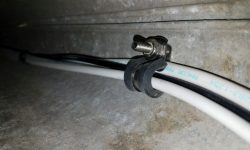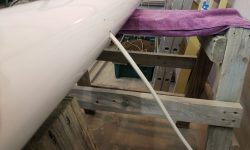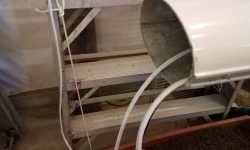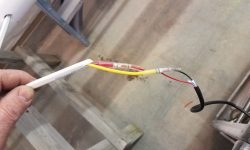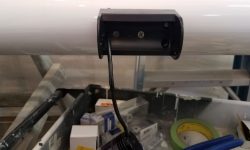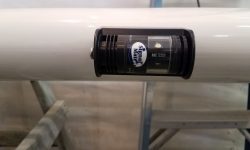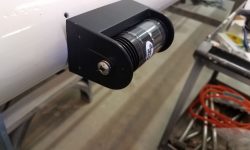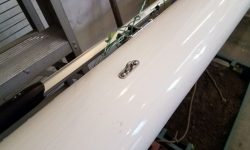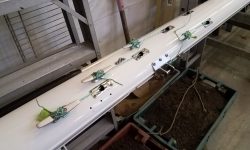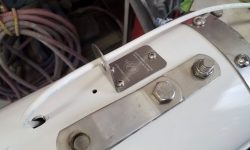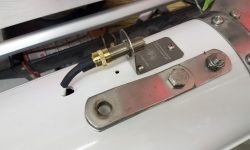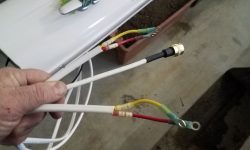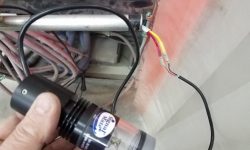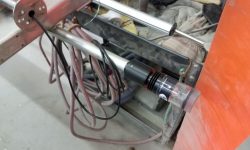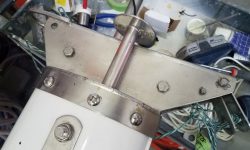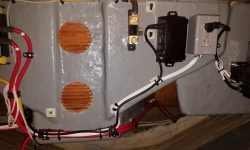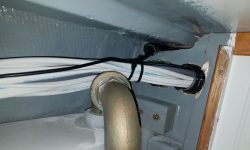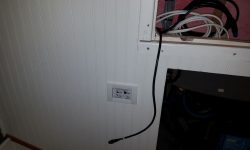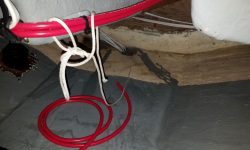January 15, 2020
Scupper 220
Wednesday
I got started by straightening out the mast wiring problem that had cropped up earlier, and at the top and bottom of the spar I secured the wire bundles with cushioned clamps flush-bolted through the aft side of the mast, inside the internal extruded track.
Next, I snaked through another wire the relatively short distance from the base of the mast to the old wiring hole from the original steaming light. From there, I could go ahead and install the new LED light fixture.
When I snaked through the wires earlier, I’d realized that the halyard messenger lines posed a problem, at least for getting my recalcitrant wire snake through the spar, and to make life easier on me, as well as prevent halyard twists and snags later, I’d removed the messenger lines at that time. Now, I ran them back through for good. One thing led to another, and with the messengers through I decided to install new cleats at the base of the mast for several of the lines. The main halyard and various control lines were to lead aft to the cockpit, but the jib, staysail, and spinnaker halyards were to stay on the mast, and thus needed the cleats. At the same time, I added a pair of small padeyes that the owner requested so he could connect wire leads over the side in a lightning storm.
At the masthead, I installed the bracket for a new VHF antenna, and made up the connector for the cable. Meanwhile, at the mast base I cut to generous length the mast wires and VHF cable and made up the ends that would later pass through the deck for connection within the boat. For now I left the wind transducer cable at full-length, though later I could install the supplied field connector after cutting the cable to a length suitable for connection to the included network box that I planned to install in the boat later in the day.
Continuing with the lighting and wiring, I installed a new anchor light at the masthead, using as a mount the long tube leftover from one of the old lights. Then I could reinstall the masthead cap with new screws. The bracket for the anemometer required a little platform wide enough to support the bolt pattern, so for now I held off on installing that particular piece.
With the mast work complete for now, I got to work in the boat to install the little network box that was required for connecting the wind instrument, and running a new cable (a network backbone) from the box aft to the cockpit area, where it would later interface with the GPS display unit. Since the transducer wire from the anemometer had to connect to the network box, I chose a location as convenient as possible for that cable, which in this case meant in the technical area beneath the V-berth. I led the cable through all the convoluted wire passages along the starboard side, through the head, and eventually into the engine room, where I could run the cable out the access panel near the electronics area. The cable end, with its usual bulky connector, was a tight fit through some of the existing wire chases, but fortunately with some effort I managed to run it without needing any new openings.
I planned to measure lavishly for the transducer cable length required to lead from the mast, through the deck, down the compression post, and forward to the network box, and would later make up the network field connector to finish that wire as well, which would allow me to remove the substantial excess wire. This promised to be a fussy little connector with tiny wires, and thus best left till some fresh early morning for me to attack, but since the deck fitting I planned to use for the cable runs would accommodate the connector easily, I thought it’d be good to make this end up now rather than leave it for commissioning. To help with the cable run later, since the bilge between the mast step and the locker space beneath the V-berth was largely inaccessible, I led a messenger line from the bilge aft of the mast step forward into the technical area (I had a similar messenger already in place on the starboard side).
Total time billed on this job today: 8 hours
0600 Weather Observation: 25°, cloudy, dusting of snow overnight. Forecast for the day: Gradually clearing, 41°



